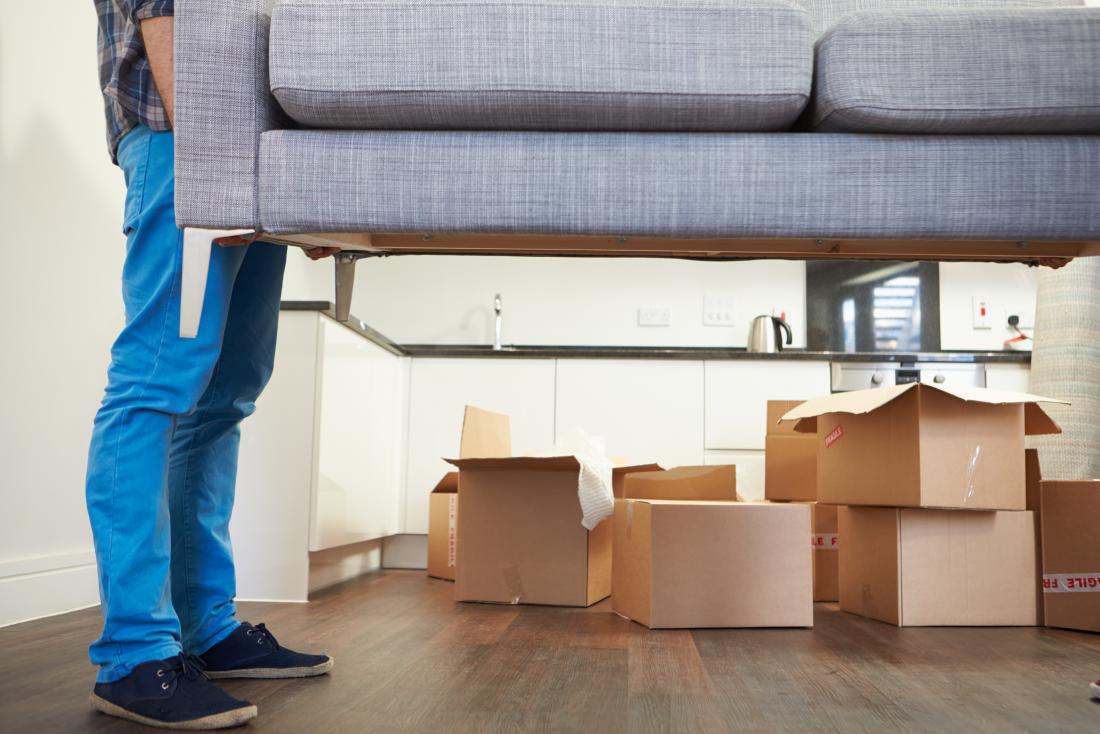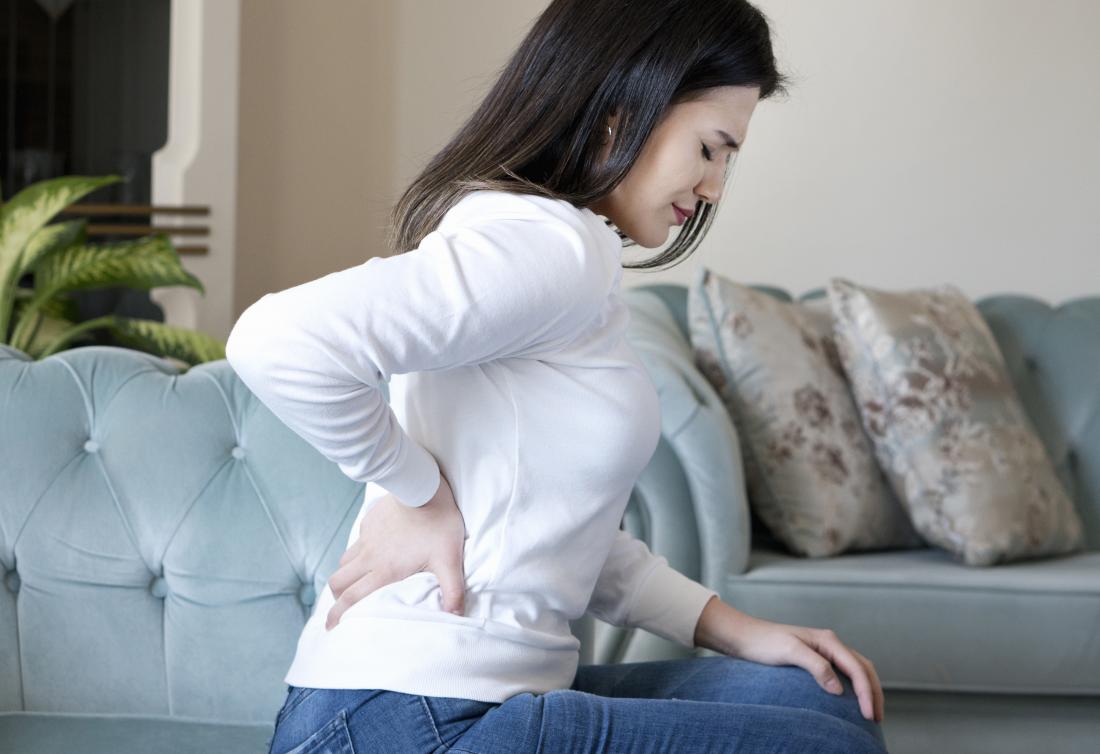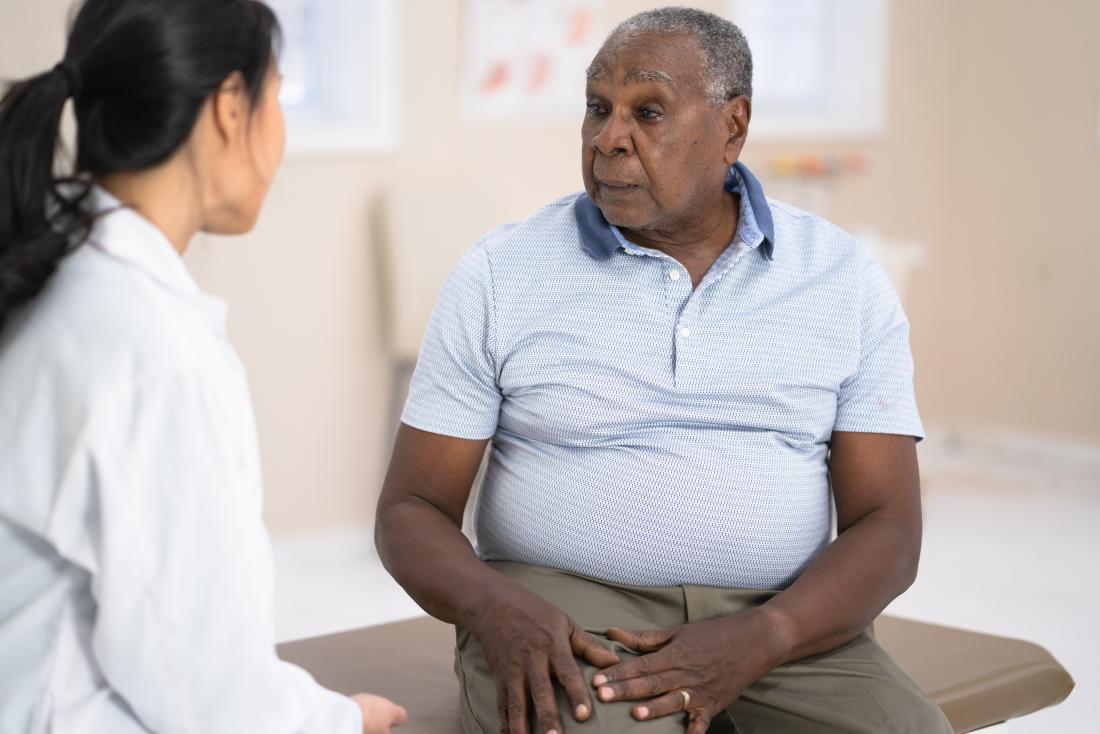In this article, we explore the possible causes of back pain on the lower right side. We also cover some causes specific to females and males and explain when to see a doctor.
Sprains and strains

Lifting heavy objects can cause sprains and strains.
A sprain occurs when a person overstretches or tears a ligament, whereas a strain refers to a torn tendon or muscle. According to the National Institute of Neurological Disorders and Stroke, strains and sprains are the leading causes of acute back pain.
Causes of sprains and strains can include:
- lifting heavy objects or using improper lifting technique
- twisting or jerking the body awkwardly
- overstretching or not warming up properly before exercise
- falling
Muscle-related back pain can range from mild to severe. The symptoms of sprains and strains can include:
- aching, stiffness, or tenderness in the lower back
- restricted range of motion due to lower back pain
- difficulty standing or sitting upright
- lower back pain that radiates into the buttocks
- muscle spasms in the lower back
The type of treatment will depend on the cause and severity of the symptoms.
A person can treat mild sprains and strains at home with rest, ice packs, and over-the-counter (OTC) pain relievers, such as acetaminophen and ibuprofen.
For people with more severe sprains and strains, a doctor may prescribe muscle relaxants and stronger pain relievers to help manage symptoms.
Other treatment options can include:
- physical therapy
- gentle massage
- stretching exercises
- electrical muscle stimulation
- surgery
Spinal stenosis
Spinal stenosis is a narrowing or compression of the spinal canal, which is the area inside the spine that contains the spinal cord. This narrowing places pressure on the spinal cord, which can cause numbness and pain that radiates to the lower back, buttocks, and legs.
Treatment options for spinal stenosis include anti-inflammatory medications, physical therapy, and steroid injections. Doctors may recommend surgery for people with severe spinal stenosis.
Appendicitis
The appendix is a small organ that connects to the first section of the large intestine. The exact function of the appendix remains unclear, but it may help support the immune and digestive systems.
Appendicitis is an inflammation of the appendix that may occur due to a blockage or an infection.
It typically causes intense pain in the right side of the abdomen. This pain can also radiate to the right side of the back.
Other symptoms of appendicitis include:
Appendicitis requires immediate medical care. People who think that they may have appendicitis should go to an emergency room immediately.
Treatment typically involves surgical removal of the appendix, which is a procedure called an appendectomy.
Kidney infection
Bacterial or viral infections that affect the urinary tract can move upstream into one or both kidneys. If a person does not receive treatment, a kidney infection can lead to serious complications, such as chronic kidney disease, kidney failure, or sepsis.
Symptoms of kidney infections include:
- pain on one or both sides of the back
- nausea and vomiting
- cloudy, dark, or bloody urine
- foul-smelling urine
- frequent urination
- a burning or painful sensation while urinating
- chills and fever
People with symptoms of a kidney infection should see a doctor as soon as possible.
Treatment for kidney infections usually involves a course of antibiotics. A doctor may also prescribe pain relievers to help ease a person’s symptoms.
Drinking plenty of water is important to prevent dehydration and fever.
Kidney stones
Certain minerals can build up in the kidneys and form hard deposits, or stones. Kidney stones vary in shape, size, and mineral content.
Small kidney stones can leave the body in the urine without causing symptoms. However, larger stones may cause blockages that can lead to sharp pain in one or both sides of the lower back. This pain may radiate to the groin and lower abdomen.
Other symptoms of kidney stones can include:
- cloudy or bloody urine
- urine that smells foul
- a frequent or urgent need to urinate
- a painful burning sensation while urinating
- fever and chills
- nausea and vomiting
People with symptoms of kidney stones should see a doctor right away.
Treatment options for people with kidney stones include:
- drinking plenty of fluids to help stones pass faster
- taking prescription medications to ease pain and other symptoms
- undergoing kidney stone removal using various procedures, such as shock wave lithotripsy, cystoscopy, and percutaneous nephrolithotomy
Ulcerative colitis
Ulcerative colitis is a chronic condition that causes inflammation of the lining of the large intestine, or colon.
Ulcerative colitis typically causes ongoing diarrhea, which may contain blood or pus. It can also cause abdominal discomfort and cramping that may radiate to one or both sides of the back.
Other symptoms of ulcerative colitis can include:
- appetite loss due to nausea
- a frequent need to have a bowel movement
- unexplained weight loss
- fatigue
- fever
- anemia
There is currently no cure for ulcerative colitis. The aim of treatment is to achieve remission, which is a sustained period during which a person has few or no symptoms.
Treatment options depend on the severity of a person’s symptoms but can include medications such as:
- aminosalicylates
- corticosteroids
- immunomodulators
- biologic therapies
If treatment does not improve the symptoms, a doctor may recommend surgical removal of the person’s colon.
Causes specific to females
Causes of pain in the lower right side of the back that are specific to females can include:
Endometriosis

Endometriosis can cause pain in the lower back or pelvis.
Endometriosis is a condition in which tissue similar to the lining of the uterus, or endometrium, grows in other parts of the body, such as the ovaries, fallopian tubes, vagina, and cervix.
Endometriosis can cause chronic pain in the lower back or pelvis.
Other symptoms of endometriosis can include:
There is currently no cure for endometriosis, so treatments focus on reducing symptoms and preventing further complications.
Treatment options for endometriosis include:
- OTC pain relievers
- hormonal birth control
- gonadotropin-releasing hormone (GnRH) agonists
- surgical procedures to remove endometriosis tissue
Uterine fibroids
Uterine fibroids are noncancerous growths that can develop in the wall of the uterus. Having them does not increase a person’s risk of developing uterine cancer.
Uterine fibroids can vary in size, and some people may not realize that they have any until a doctor detects them during a pelvic exam or an ultrasound.
Not everyone with uterine fibroids will experience symptoms, which can include:
People without symptoms may not require treatment.
Treatment options can include:
- OTC pain relievers
- hormonal birth control
- GnRH agonists
- surgical procedures to remove fibroid growths, the lining of the uterus, or the entire uterus
Pelvic inflammatory disease
Pelvic inflammatory disease (PID) is an infection that typically occurs when a sexually transmitted disease, such as gonorrhea or chlamydia, spreads to the uterus, ovaries, or fallopian tubes.
Symptoms of PID can vary in severity and may include:
- pain in the lower abdomen or back
- unusual or unpleasant-smelling vaginal discharge
- pain during or after vaginal intercourse
- painful urination
- fever and chills
- nausea and vomiting
People with symptoms of PID should see a doctor as soon as possible. Prompt treatment can prevent or minimize scarring that can increase the risk of fertility problems and ectopic pregnancies.
Antibiotics can usually cure the bacterial infection that causes PID.
Pelvic pain during pregnancy
Some women experience pelvic pain during pregnancy. Pelvic pain can affect one or both sides of the lower back.
This pain may also affect the perineum or radiate to the thighs. It may worsen while walking, standing up, or rolling onto the side.
The following tips may help reduce pelvic pain during pregnancy:
- doing exercises that strengthen the pelvic floor
- stretching
- taking warm baths
- wearing flat, comfortable shoes
- avoiding standing for too long
- getting plenty of rest
Women can also try applying ice or heat packs to help ease the pain. OTC acetaminophen is generally safe to take during pregnancy. However, it is advisable to speak to a doctor before taking any medications while pregnant.
Causes specific to males
Testicular torsion can cause back pain on the lower right side in males.
Testicular torsion
Testicular torsion occurs when the testicle rotates inside the scrotum, causing the spermatic cord to twist. A twisted spermatic cord can reduce or completely block blood flow to the testicle, which can cause irreversible damage.
Symptoms of testicular torsion can include:
- severe and unexpected pain in the testicle or groin
- pain that radiates to the right or left side of the back
- swelling of the scrotum
- nausea
- vomiting
- blood in the semen
Testicular torsion is a medical emergency, and anyone who experiences these symptoms should seek immediate medical attention.
Treatment involves a surgical procedure to either untwist the spermatic cord or remove the testicle.
When to see a doctor

A person who experiences severe or worsening back pain should speak to a doctor.
People with severe, persistent, or worsening lower back pain should consult a doctor right away.
Also, seek medical attention for lower back pain that accompanies:
- painful urination
- cloudy, bloody, or foul-smelling urine
- stools containing blood or pus
- fever
- nausea
- vomiting
- pain during or after sex
- severe groin pain
- irregular periods
Summary
Lower back pain is very common. Possible causes of lower back pain on the right side include sprains and strains, kidney stones, infections, and conditions that affect the intestines or reproductive organs.
People should speak with a doctor if they experience lower back pain that does not improve with rest or affects daily life.
